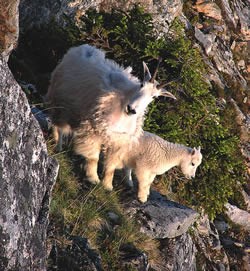
NPS Photo / M. Gray Oreamnos americanusBasic FactsIn Southcentral Alaska, there are two all white species of hoofed animals that roam the mountains: Dall sheep and mountain goats. In Kenai Fjords National Park and the surrounding area, only the mountain goat exists. Sheep can be found further inland, where the snow tends to be drier and access to food sources easier. Goats, on the other hand, tend to be stronger and larger and are thus better able to access food in the park, where snow is heavier and wetter. Mountain goats are not a member of the same subfamily that includes "true goats", instead belonging to a type of bovid known as "goat-antelopes". The hooves of mountain goats consist of two toes that can move independently from each other, allowing for its stunning agility on steep terrain. Mountain goats are very muscular animals with well-developed shoulder muscles to give it great climbing strength and aid in its ability to dig for food in winter. Both male and female mountain goats have black shiny horns that grow about 8-12 inches in length. Horns produce annual growth rings that can age the goat: A two-year-old has one ring, a three-year-old has two, and so on. Their fur is thick and long with coarse hollow guard hair that grows nearly eight inches long to keep them warm in the winter. Habitat, Range and Local SightingsThe mountain goat is found among the steep and rugged mountains of northwestern North America from Idaho to Washington, through British Columbia and into Southcentral Alaska. Mountain goat populations are scattered throughout this range and can be found from sea level to elevations over 10,000 feet. In Alaska, mountain goats occur throughout the southeastern Panhandle, and north and west along the coastal mountains to Cook Inlet. Their range extends into the Talkeetna Mountains nearly to Denali National Park. It is estimated that 3,600 to 4,600 mountain goats occupy the Kenai Peninsula. Goats are often spotted while climbing the Harding Icefield Trail during the late spring and summer months. Boat tours in Resurrection Bay often see goats between Caines Head and Callisto Head on the west side of the bay. This area has been nicknamed “goat alley” since it is not uncommon to spot nannies right next to the shoreline where they give birth to their kids during the last week of May and first week of June. Later in the season, as the nannies move into the alpine areas, goats are spotted in large groups at high elevations all around the bay. Food and Survival StrategiesThe mountain goat is a very versatile eater, consuming lichens, ferns, grasses, herbs, shrubs, and deciduous or coniferous trees. In the spring and early summer, they follow the flush of nutritious new growth up hill. By summer, goats usually graze on grasses, lichens and low-growing shrubs in high alpine meadows. Goats move to lower elevations in winter where hemlock and lichen become more prevalent in the diet. Toward the end of winter and beginning of spring, goats in the park work their way down to the intertidal zone. After an impoverished winter diet, they increase their salt and mineral intake by feeding on kelp. Bears, wolves, eagles, and wolverines are all predators of the mountain goats, especially first-year kids. Much of the mountain goat’s behavior is a strategy to avoid these animals. Climbing on steep, rocky slopes that other animals can’t navigate is their most frequent form of defense. Females travel close behind kids where eagles might try to knock them off their feet. In the end, gravity and avalanches take more mountain goats than any animal seeking prey. Reproduction and YoungFemale mountain goats breed for the first time when they are about two years old. Although males are also sexually mature at this time, the older more dominant billies usually do the breeding. Males begin to get ready to rut in November, when they dig urine pits where they can wallow, soil, and scent their coats. During this time, billies spend little time eating and there is an increase in threats to other males as they begin following nannies at a distance. Only when the nannies are in estrus will the billies approach closely. Mating begins with low body stretches, lip curls, and nuzzling by the males. Gestation takes about six months. In Kenai Fjords, pregnant females make their way down steep cliffs to the sea to give birth. Nannies find secluded beaches with surrounding territory that only a goat could scale. Nannies give birth to one kid, and rarely to twins, that is ready to ascend the steep cliffs 10 to 14 days after birth. Once the nanny and her kid are back in the mountains, they will group together with other nannies and kids forming bands of 5-20 animals. Billies are never found in these bands and are generally loners outside of the rutting season. Human ConnectionsThe mountain goat’s precipitous habitat has protected it not only from four-footed predators but also from bipedal humans. It wasn’t until 1900 that much was known about this cliff-hopping creature. There are early stories of Captain Cook obtaining mountain goat hides, but at that time he assumed they were the pelts of some unknown bear species. Alaska Natives have used goat fur for blankets and the hide of the animal acted as ‘non-skid’ treads for the soles of their shoes. Goat horns were softened with steam, and then bent and carved into serving utensils by Alutiiq craftsmen. |
Last updated: March 22, 2024
